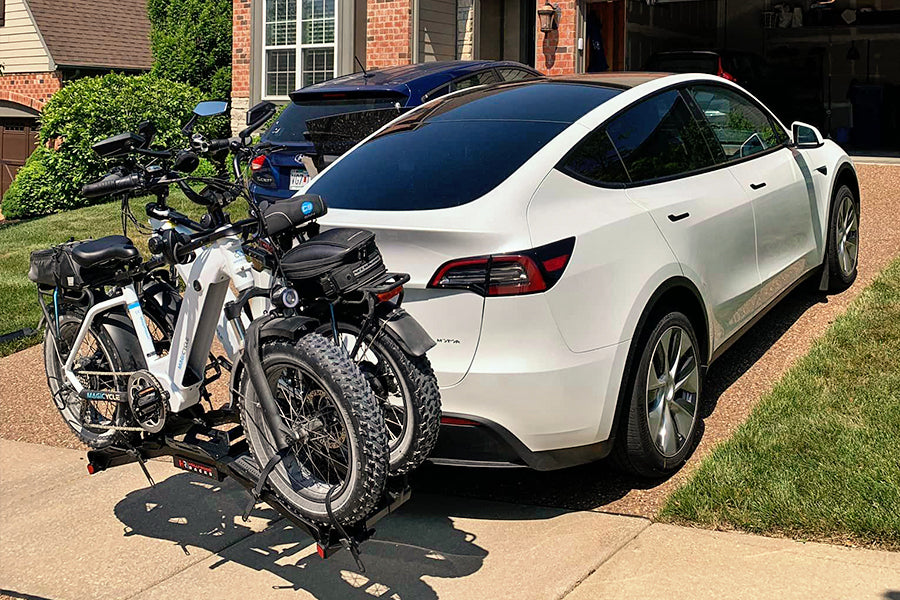To transport electric bikes, use a bike rack or a specialized bike carrier that can securely hold the bikes in place during transport. Electric bikes are heavier than regular bikes, so it’s important to choose a carrier that can handle the extra weight and provide proper support.
Electric bikes have gained popularity in recent years due to their eco-friendly nature and convenience. However, when it comes to transporting them, it can be a bit more complicated than transporting regular bikes. Electric bikes are generally heavier and bulkier, which means you need to take extra precautions to ensure their safety during transport.
We will discuss some methods and tips for transporting electric bikes safely and efficiently. Whether you are planning a road trip or just need to transport your electric bike to a new location, these tips will help you do it effectively.

Credit: electricbikesbrisbane.com.au
Preparing For Transportation
Transporting electric bikes can be made easy with these simple tips. Ensure to secure the bikes properly, remove the battery, deflate the tires slightly, and protect them with padding or covers for a smooth and hassle-free transportation experience.
Choosing The Right Vehicle
Before transporting your electric bike, it’s essential to consider the type of vehicle you will be using. Not all vehicles are suitable for transporting electric bikes due to their weight and size. Ideally, you should choose a vehicle that can accommodate the bike without any hassle. A pickup truck or a van with enough cargo space would be ideal. Make sure to measure the dimensions of your bike and compare them with the available space in the vehicle to ensure a proper fit.
Removing The Battery
One crucial step in preparing your electric bike for transportation is removing the battery. The battery is not only heavy but also a sensitive component that needs to be handled with care. By detaching the battery, you reduce the weight of the bike, making it easier to transport.
Additionally, removing the battery also eliminates the risk of any damage occurring to it during the journey. To remove the battery, refer to your bike’s user manual for specific instructions. In most cases, you will need to locate the battery release mechanism and unlock it using a key or a tool provided with your bike. Once unlocked, carefully slide the battery out from its compartment. Remember to store the battery in a secure, upright position, away from any sharp objects or extreme temperatures.
Securing The Bike
Properly securing your electric bike during transportation is crucial to prevent any scratches or damage. Without proper securing, your bike might move around inside the vehicle, potentially causing harm to both the bike and the vehicle itself. Several methods can be employed to secure your electric bike effectively:
- Use bungee cords or adjustable straps to fasten the bike to anchor points within the vehicle. Make sure the straps are tight enough to prevent any movement, but not too tight to damage the bike’s frame.
- If necessary, consider using foam or padding in areas where the bike might come into contact with the vehicle’s interior. This will provide an extra layer of protection against scratches or dents.
- Consider investing in a bike rack if you plan on transporting your electric bike frequently. A bike rack provides a secure and stable platform for your bike, keeping it locked in place during transportation.
By choosing the right vehicle, removing the battery, and securing the bike properly, you can ensure a smooth and safe transportation experience for your electric bike. Taking these precautions will not only protect your bike from potential damage but also provide you with peace of mind throughout the journey.

Credit: tuoteg.com
Transportation Methods
Transporting electric bikes can be made easy by using various transportation methods such as hitch-mounted bike racks, roof-mounted bike racks, and folding electric bikes that can fit into smaller vehicles for convenient transportation.
Transporting electric bikes can be a breeze if you use the right methods. Whether you’re heading out for a biking adventure or need to transport your electric bike for repairs, knowing the best transportation methods is essential. In this article, we’ll explore three effective ways to transport your electric bike: using a bike rack, using a truck or van, and using a trailer.
Using A Bike Rack
Using a bike rack is an efficient and popular method to transport your electric bike. A bike rack attaches to the rear of your vehicle, providing a secure and stable platform to transport your bike. Here’s how you can make the most of it:
1. Choose a suitable bike rack: Ensure that the bike rack you choose is compatible with electric bikes. Look for a rack that can support the weight and dimensions of your electric bike.
2. Install the bike rack: Follow the manufacturer’s instructions to correctly install the bike rack on your vehicle. Double-check that it is securely fastened to avoid any mishaps during transportation.
3. Load your electric bike: Carefully place your electric bike on the bike rack, making sure it is balanced and stable. Securely fasten the bike using straps or clips provided with the rack.
4. Check the bike rack regularly: Before and during your journey, periodically check the bike rack to ensure it remains secure and stable. Avoid excessive speeds and sudden braking to prevent any damage to your electric bike or the rack.
Using A Truck Or Van
If you own a truck or van, transporting your electric bike becomes even more convenient. Here’s how you can do it:
1. Clear out space: Empty the back of your truck or van to create enough space for your electric bike. Remove any obstacles and secure loose items to prevent damage to your bike.
2. Use ratchet straps: Position your electric bike in the truck or van, ensuring it rests securely on its wheels. Attach ratchet straps to secure the bike tightly to anchor points within the truck or van.
3. Protect your bike: Use blankets or foam padding to protect your electric bike from scratches and dents during transportation. Pay special attention to delicate parts such as the frame, pedals, and handlebars.
4. Drive with caution: Maintain a safe and steady speed while driving to prevent any sudden movements that could harm your electric bike. Take corners slowly and avoid rough roads whenever possible.
Using A Trailer
If you need to transport multiple electric bikes or have limited space in your vehicle, using a trailer is an ideal solution. Follow these steps for a smooth and secure transportation experience:
1. Choose the right trailer: Select a trailer that accommodates the number of electric bikes you need to transport. Ensure that it has sturdy construction, reliable wheels, and a secure attachment system.
2. Load the electric bikes: Load your electric bikes onto the trailer one at a time, ensuring they are evenly distributed for balance. Secure each bike using straps or clamps to prevent any movement during transit.
3. Check the trailer connection: Before hitting the road, double-check that the trailer is properly connected to your vehicle. Ensure the lights and brakes are functional for safe transportation.
4. Drive carefully: Be mindful of the added weight and length when driving with a trailer. Give yourself extra time to brake and make turns, maintaining a safe following distance. By utilizing these transportation methods – using a bike rack, using a truck or van, and using a trailer – you can transport your electric bike hassle-free. Whether you’re embarking on a thrilling bike adventure or simply need to get your electric bike from one place to another, these methods will ensure a safe and secure journey.
Safety Tips
Transporting your electric bike requires careful attention to ensure it reaches its destination safely. By following these safety tips, you can protect your bike from damage and ensure a smooth journey.
Securing The Bike Properly
When loading the electric bike onto your vehicle for transportation, it is crucial to secure it properly to prevent any accidents or damage. Here’s how you can do it:
- Use sturdy bike racks or carriers that are designed specifically for electric bikes. These racks provide a secure fit and prevent the bike from moving or wobbling during transit.
- Position the bike in such a way that it is stable and has minimal contact with other objects. Avoid any contact with sharp edges or protruding parts.
- Use high-quality straps or bungee cords to fasten the bike to the rack or carrier. Ensure that the straps are tight enough to keep the bike in place, but not so tight as to cause any damage.
- Double-check the security of the bike before hitting the road. Give the bike a gentle shake to check if it is firmly secured and won’t budge during transportation.
Protecting The Bike From Damage
Electric bikes can be quite expensive, so it’s essential to protect them from any potential damage during transportation. Follow these tips to keep your bike safe:
- Use protective covers or padding to shield the bike’s frame and delicate components from scratches, dings, or other physical damage.
- If you’re transporting multiple bikes, ensure that they are adequately spaced apart to avoid collisions or scratching against each other.
- Consider removing the battery from the electric bike and storing it separately during transportation. This will minimize the risk of any damage to the battery and its electrical connections.
- Pay attention to the weather conditions during transportation. If it’s raining or snowing, use waterproof covers or tarps to protect the bike from moisture.
Checking The Bike After Transportation
After reaching your destination, it’s essential to inspect the electric bike for any signs of damage or loosening due to transportation. Here’s what you need to do:
- Examine the bike’s frame, wheels, and other components for any visible damage or misalignment. Look for cracks, dents, or bent parts that may have occurred during transportation.
- Check the tightness of all bolts and screws, especially those holding critical parts like the handlebars, seatpost, and pedals. Tighten them if necessary, but be careful not to overtighten.
- Inspect the electrical connections and wires to ensure they haven’t come loose or disconnected during transit. Reconnect any loose connections and ensure they are secure.
- Test the bike’s brakes, gears, and other functionalities to ensure they are functioning correctly. Take a short test ride to verify that everything is in working order.

Credit: www.magicyclebike.com
Frequently Asked Questions For How To Transport Electric Bikes
What Is The Best Way To Transport An Electric Bike?
The best way to transport an electric bike is by using a hitch-mounted bike rack or a roof-mounted rack on a vehicle. These racks provide secure and safe transportation, protecting the bike and allowing for easy loading and unloading.
How Do You Travel With An Electric Bike?
Traveling with an electric bike is easy! Follow these tips: 1. Remove the battery and secure it for safe transport. 2. Deflate the tires slightly to prevent pressure build-up. 3. Use a bike travel bag or sturdy box for protection.
4. Carefully wrap and anchor all loose parts. 5. Check airline regulations and pack accordingly.
Is It OK to Lay an Electric Bike On Its Side?
Yes, it is generally fine to lay an electric bike on its side. However, it’s best to avoid doing so for an extended period to prevent potential damage to the bike’s components and battery.
Do Electric Bikes Need Special Bike Racks?
Electric bikes do not require special bike racks. They can be transported on regular bike racks just like traditional bicycles.
Conclusion
Transporting electric bikes can be a breeze with the right knowledge and equipment. Whether you’re planning a road trip or need to transport your bike for repairs, following these tips will ensure a safe and convenient journey. From securing your bike properly with the right racks and straps to removing the battery and covering delicate parts, taking these precautions will help you avoid any damage.
Remember to always check your local laws and regulations for transporting electric bikes, ensuring a worry-free adventure wherever the road takes you.



